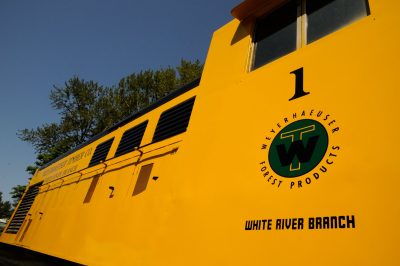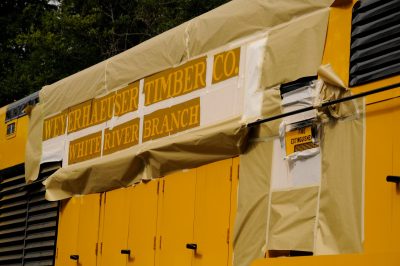
Locomotive 1 with Weyerhaeuser’s traditional W/T logo as applied in 1951. This new lettering was applied at the Museum’s CRC in 2011.
The White River Branch was a Weyerhaeuser operation near Enumclaw in east King County, Washington. They had a logging railroad that stretched to the outer reaches of Mount Rainier National Park, and a spur line that connected with the Northern Pacific Railway and Milwaukee Road.

The “T” in the Weyerhaeuser W/T logo is evident under the paint mask as the three layers of paint that make up the logo are applied.
In 1951 “a great yellow beast” (as described in the company’s newsletter) arrived to replace a steam locomotive and was soon working in the woods. Service on the logging railroad was short-lived because Weyerhaeuser converted to trucks just a few years later. Yet #1 soldiered on pulling trains to interchange with the Northern Pacific and Milwaukee lines for close to another two decades. (For more on the history, visit the September 28, 2010 blog post.)
The White River Branch’s #1 received extensive rehabilitation in 2009 & 2010 funded in part by a grant from the National Railway Historical Association. Work included replacement of worn upper pistons and rings, car body repairs, electrical work, replacement of damaged glass, and priming and painting. Owing to a particularly wet and cool fall, winter and spring, lettering of the locomotive was delayed until summer 2011.

The eight and six inch lettering on the long hood first appears as an outline as the lettering mask is exposed just prior to applying black paint.
Armed with accurate tracings made off the remnants of the original lettering, volunteer Rich W. scanned and smoothed the lettering. He traced it out and “printed” it on a vinyl cutter to create a paint mask. The mask was applied to the locomotive using low-tack release paper and the lettering was painted out. When the lettering mask was removed, the crisp new lettering remained. This technique is similar to how the original lettering was applied in 1951 to this model H12-44 at Fairbanks Morse in Beloit, Wisconsin. While today a similar project would probably be lettered with vinyl, this traditional technique should outperform even the best vinyl. And it is historically accurate too!
Later this month, locomotive 1 will be moved into its permanent new home inside the Northwest Railway Museum’s Train Shed in Snoqualmie, Washington. There, this class A rehabilitation effort will be protected from the Northwest’s winter rains and will be part of an exhibit about logging by rail.


Spike, Nice addition for the museum's collection. Hopefully we'll get up that way in 2012 and then have a chance to visit the exhibit. Take Care, Big Daddy Dave